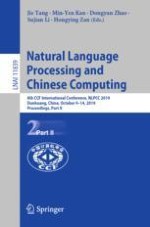2019 | OriginalPaper | Chapter
A Category Detection Method for Evidence-Based Medicine
Authors : Jingyan Wang, Shenggen Ju, Xi Xiong, Rui Zhang, Ningning Liu
Published in: Natural Language Processing and Chinese Computing
Publisher: Springer International Publishing
Activate our intelligent search to find suitable subject content or patents.
Select sections of text to find matching patents with Artificial Intelligence. powered by
Select sections of text to find additional relevant content using AI-assisted search. powered by
